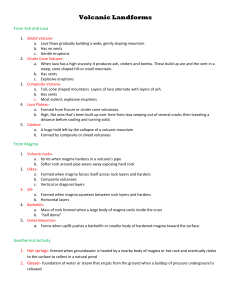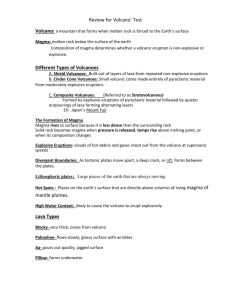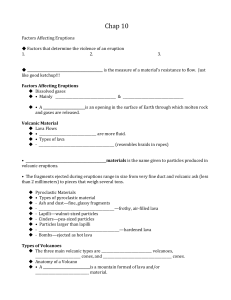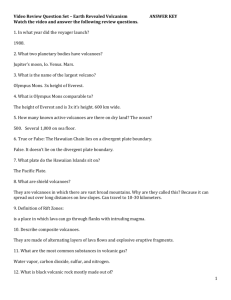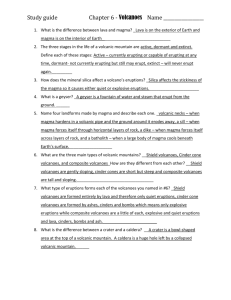Subduction Zones Many volcanoes are located along subduction
advertisement
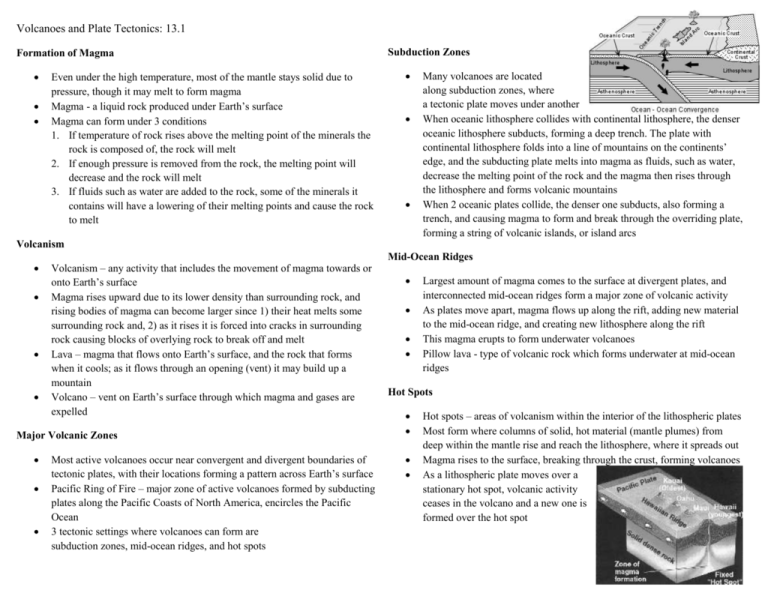
Volcanoes and Plate Tectonics: 13.1 Formation of Magma Even under the high temperature, most of the mantle stays solid due to pressure, though it may melt to form magma Magma - a liquid rock produced under Earth’s surface Magma can form under 3 conditions 1. If temperature of rock rises above the melting point of the minerals the rock is composed of, the rock will melt 2. If enough pressure is removed from the rock, the melting point will decrease and the rock will melt 3. If fluids such as water are added to the rock, some of the minerals it contains will have a lowering of their melting points and cause the rock to melt Subduction Zones Many volcanoes are located along subduction zones, where a tectonic plate moves under another When oceanic lithosphere collides with continental lithosphere, the denser oceanic lithosphere subducts, forming a deep trench. The plate with continental lithosphere folds into a line of mountains on the continents’ edge, and the subducting plate melts into magma as fluids, such as water, decrease the melting point of the rock and the magma then rises through the lithosphere and forms volcanic mountains When 2 oceanic plates collide, the denser one subducts, also forming a trench, and causing magma to form and break through the overriding plate, forming a string of volcanic islands, or island arcs Volcanism Volcanism – any activity that includes the movement of magma towards or onto Earth’s surface Magma rises upward due to its lower density than surrounding rock, and rising bodies of magma can become larger since 1) their heat melts some surrounding rock and, 2) as it rises it is forced into cracks in surrounding rock causing blocks of overlying rock to break off and melt Lava – magma that flows onto Earth’s surface, and the rock that forms when it cools; as it flows through an opening (vent) it may build up a mountain Volcano – vent on Earth’s surface through which magma and gases are expelled Major Volcanic Zones Most active volcanoes occur near convergent and divergent boundaries of tectonic plates, with their locations forming a pattern across Earth’s surface Pacific Ring of Fire – major zone of active volcanoes formed by subducting plates along the Pacific Coasts of North America, encircles the Pacific Ocean 3 tectonic settings where volcanoes can form are subduction zones, mid-ocean ridges, and hot spots Mid-Ocean Ridges Largest amount of magma comes to the surface at divergent plates, and interconnected mid-ocean ridges form a major zone of volcanic activity As plates move apart, magma flows up along the rift, adding new material to the mid-ocean ridge, and creating new lithosphere along the rift This magma erupts to form underwater volcanoes Pillow lava - type of volcanic rock which forms underwater at mid-ocean ridges Hot Spots Hot spots – areas of volcanism within the interior of the lithospheric plates Most form where columns of solid, hot material (mantle plumes) from deep within the mantle rise and reach the lithosphere, where it spreads out Magma rises to the surface, breaking through the crust, forming volcanoes As a lithospheric plate moves over a stationary hot spot, volcanic activity ceases in the volcano and a new one is formed over the hot spot Volcanic Eruptions: 13.2 Two types of lava are Mafic and Felsic Mafic lava is magma/rock rich in magnesium and iron, and is commonly dark Felsic lava is rich in light-colored silicate and feldspar materials Mafic rock commonly makes up the oceanic crust, while mafic and felsic rock make up continental crust Types of Eruptions A volcano’s eruption force is affected by the viscosity, or resistance to flow, of magma Magma’s viscosity is determined by its composition Mafic magma produces runny lava with a low viscocity and therefore causes quieter eruptions Felsic magma produces sticky lava with a high viscosity and therefore causes explosive eruptions Magma with a lot of trapped gases is more likely to produce explosive eruptions Quiet Eruptions Oceanic volcanoes which form from mafic magma have quiet eruptions because of mafic magma’s low viscosity and because gases can easily escape from it Types of Volcanoes Volcanic activity produces a variety of features that form during both quiet and explosive eruptions Lava and pyroclastic material ejected during eruptions build up around a vent and form volcanic cones Funnel shaped pit at the top of a volcanic vent is a crater 3 main types of volcanoes are shield, cinder, and composite Shield Volcanoes Broad based with gently sloping sides and covers a wide area Generally forms from quiet eruptions, and the layers of hot, mafic lava flow out around the vent, harden, and slowly build up to form the cone Cinder Cones Has very steep slopes with an angle up to 40 0 and are rarely over a few hundred meters high Form from explosive eruptions and are made of pyroclastic material Explosive eruptions Composite Volcanoes Continental volcanoes which produce felsic lava have explosive eruptions because of the magma’s high viscosity, and because gases such as water vapor and CO2 are trapped in it and cause the lava to explode in different directions as it escapes from the lava in an eruption This throws pyroclastic material, which consists of fragments of rock formed during a volcanic eruption, into the air Made up of alternating layers of hardened lava flows and pyroclastic material Lava flows cover the sides of the cone during quiet eruptions and pyroclastic material is deposited around the vent during explosive eruptions Composite volcanoes are also known as stratovolcanoes and commonly develop to form huge volcanic mountains Calderas Caldera – a large, circular depression that forms when the magma chamber below a volcano partly empties and causes the ground above to sink

